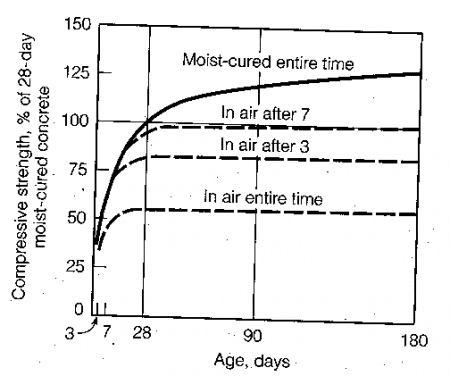Concrete Compressive Strength Variation with Time
The age of concrete structures have lots to do with its strength and durability properties. Understanding the strength-time relationship of concrete helps to know the effect of loading at a later age.
The different effects on concrete strength with age are explained in this section.
Variation of Concrete Strength with Time
As per studies and researches, the compressive strength of the concrete will increase with age. Most researches were conducted to study the 28th-day strength of concrete. But in reality, the strength at 28th day is less compared to the long-term strength that it can gain with age.
The concrete strength variation with age can be studied by different methods. The figure-1 below shows the strength variation of a concrete present at dry and wet condition. This graph is based on the study conducted by Baykof and Syglof (1976).
They found that, in dry conditions, after 1 year there is no increase in concrete strength, as shown in figure-1. On the other hand, the strength of specimens stored in a wet environment (at 15°C) is considerably increased.


Rate of Strength Gain With Time
The process of continued hydration will increase the strength of concrete. If the environmental conditions to which the concrete is exposed facilitates the hydration, the strength is gained continuously with age. But this rate of hydration is fast at the early stages and delays later.
The compressive strength gained by concrete is thus measured at its 28th day after which the rate of strength is lowered. The compressive strength gained at later ages are tested by means of non-destructive tests.
The table-1 below shows the rate of strength gained from the first day to 28th day.
Table.1: Strength Gained by Concrete With Age
| Age | Strength Gained (%) |
| 1 day | 16% |
| 3 days | 40% |
| 7 days | 65% |
| 14 days | 90% |
| 28 days | 99% |
Proper curing conditions will help in preventing the escape of moisture that will facilitate strength gain reactions.The figure-3 below shows the variation of compressive strength with age for different curing conditions.

Factors Affecting Long-term Compressive Strength of Concrete
The achievement of concrete compressive strength in long term is different from early age strength gain. The different factors affecting the long-term compressive strength of concrete are:
1. Water-Cement Ratio
An adequate water-cement ratio is necessary to undergo hydration reactions at later ages. Hydration reactions improve the compressive strength of concrete.
Inadequate water content will leave a tremendous amount of pore before 28 days that will increase the chances of creep and shrinkage issue with time. This will affect the compressive strength of concrete adversely.
2. Curing Conditions
Proper curing conditions is a kind of preparation of concrete before letting it to service conditions. The extent of curing of concrete is performed based on the anticipated exposure conditions of the structures.
Properly cured and high-quality concrete is not affected by extreme conditions with age. Effective curing hence improves the concrete compressibility.
3. Temperature
Studies have shown that high temperature speeds up the hydration reaction, but the products gained won’t be uniform or of good quality. This can leave pores which affect the strength of concrete.
4. Environmental Conditions
Concrete structure with age is subjected to environmental conditions like rain, freezing and thawing, chemical attacks etc. An impermeable concrete can undergo moisture penetration, frequent freeze, and thaw that creates cracks in concrete.
Chemical attacks can corrode the reinforcement reducing the yield strength of reinforcement. All these can affect the concrete strength capacity.

No comments:
Post a Comment